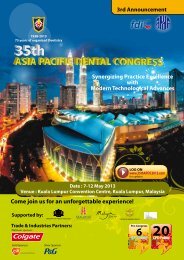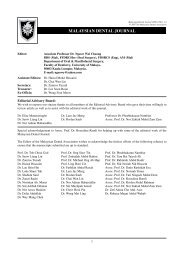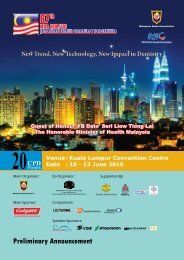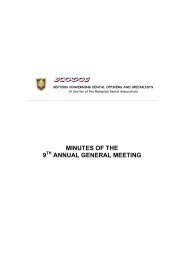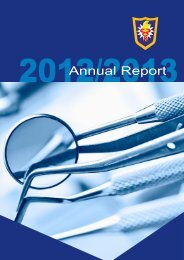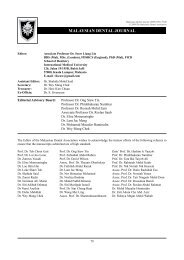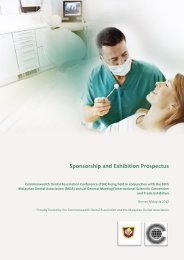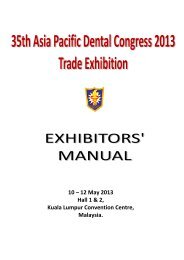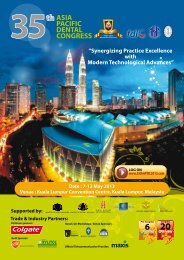PDF(6.5mb) - Malaysian Dental Association
PDF(6.5mb) - Malaysian Dental Association
PDF(6.5mb) - Malaysian Dental Association
- No tags were found...
You also want an ePaper? Increase the reach of your titles
YUMPU automatically turns print PDFs into web optimized ePapers that Google loves.
Single Tooth Odontodysplasia- Case Report With Review Of Literatureaffected teeth was the reason for the term ‘ghostteeth’ 16,35 . The pulp chambers and root canals arewide, and the roots are shorter with wide and openapices15. Calcifications are occasionally seen withinthe pulp chambers or rootcanals36. In some cases,the unerupted teeth are surrounded by a pericoronalradiolucency representing an enlarged dental follicle 15 .Histologically, all structures of the dental germare affected. In ground section, the enamel is ofvariable thickness, producing an irregular surface 5 .The enamel prisms are irregular and the enamelmay occasionally lack a prismatic structure 5 , andit is hypoplastic and contains degenerated globularcalcifications 37 . There is also hypocalcification of theenamel because residual enamel matrix is frequentlyseen in demineralised section 38 . The dentine is thin,and the tubules are reduced in number and tortuousin shape 32 . Interglobular dentin and globular massesinterrupting the dentinal tubules are frequentlyseen. Clefts within dentine some of which establishcommunication between the pulp and the oral cavity,are common findings 5 . Cellular dentine and amorphousares within the coronal dentine are usually evident 10 .Closer to the dentino-enamel junction, dentine is moreevenly calcified 32 . Although predentine is of variablethickness, it is usually wider than that seen in normalteeth 39 . Prominent interglobular dentine is also seenin the radicular dentine; however the radicular dentineand cementum are generally less abnormal comparedwith coronal dentine 40 . The pulp chamber is large withoccasional long pulp horns, and often contains largeirregular, calcified globules or stones 32 . Pulp necrosisis often noted as a result of the communication withthe oral cavity through the dentinal clefts and pulphorns 10 . There is strong trend for teeth which developrelatively late to have more normal structure thanthose which develop early in life<strong>Dental</strong> follicle is composed of dense fibrousconnective tissue 16,37,41 . odontogenic epitheliumrests, whorled fibrous tissue and foci of calcificationwhich occasionally coalesce into large globules arefrequently seen within dental follicle 5 . The enlargedgingival which accompanies the affected teeth insome cases usually shows a parakeratinized surfaceepithelium with acanthosis and very hyperplastic reteridges. The lamina propria is composed of fibrousconnective tissue and contains chronic inflammatorycell infiltrate 32 . Calcified globules and odontogenicepithelium rosettes similar to those found in thedental follicle are also sometimes observed insidethis tissue 32 . The calcifications are thought to be theresult of: degenerative changes of the reduced enamelorgan 38 ; degenerative change of the connectivetissue cells 27 ; earlier inflammation 42 ; or formation bymetaplastic epithelial cells 14 .Treatment of RO is controversial and no consensushas yet been reached, thus individualized managementis the best option. Most dentist elect to extract theteeth involved immediately and later rehabilitate thepatient with a temporary removable partial acrylicprosthesis because, even if they erupt, the teeth aredefective and of undesirable appearance 8,31,43,44 . Thelonger the teeth are retained, the higher the chances ofpathology developing. This will necessitate extractionof the teeth, and their removal may be more difficult,especially if they are unerupted 39 . The temporaryprosthesis can be maintained till the age of 17 or 18years, a time when the gingival margin is stable andrestoration with a fixed prosthesis can be considered.In our case also surgical removal of maxillary centralincisor was done, followed this aesthetic and functionalacrylic space was installed. The patient was kept underobservation and periodic recall was advised to monitorthe development of dentition and craniofacial growth.Others clinicians have argued that removal of teeth at ayoung age may lead to undesirable psychological effects,and a substantial reduction in alveolar ridge height. Thisloss of vertical dimensions on the affected side mightlead to defective jaw development and subsequentfacial asymmetry 14 . However, it is questionable ifnegative influences on the facial skeleton growth couldbe potentiated by this approach 12,32 .Placement of osteo-integrated implants ingrowing children with hypodontia is well documentedin literature 45-47 . Since the general quality of bone isnot affected in RO, there may be a role for implantsin such cases. Nevertheless, care must be taken whencarrying out such procedures since there have beenreports of a lower density of bone around affectedteeth 7 .Recents reports have shown dental structuredevelopment in RO patients, suggesting alternatives forthe radical approach 12,33 . One case of RO was followedradiographically for 9-year period, during which timethe ghost teeth exhibited progressive development ofdental tissues including complete root formation 48 .Some clinicians have even suggested movingthese teeth which have the most – developed rootsorthodontically with subsequent restorations or fixedprosthesis on the pillar elements remaining 49 .Finally the goal of treatment is to recover speechand masticatory function, improving aesthetics, andreduce psychological impact, while allowing normaljaw growth and development.In conclusion, a single tooth can manifest asodontodysplasia. It is quite possible the cliniciansmisdiagnose this rare entity; however a good historyand appropriate radiograph can help in the diagnosisof this typical “ghost tooth” appearance.<strong>Malaysian</strong> <strong>Dental</strong> Journal Jan-Jun 2011 Vol 32 No 148



